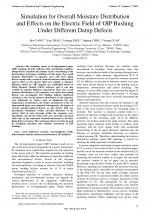| 2/2024 - 2 |
Simulation for Overall Moisture Distribution and Effects on the Electric Field of OIP Bushing Under Different Damp DefectsYANG, H. |
| Extra paper information in |
| Click to see author's profile in |
| Download PDF |
Author keywords
dielectric constant, electromagnetic fields, finite element analysis, moisture measurement, oil insulation
References keywords
insulation(15), power(13), moisture(13), transformer(10), paper(9), tdei(7), diffusion(7), transformers(6), liao(6), board(6)
Blue keywords are present in both the references section and the paper title.
About this article
Date of Publication: 2024-05-31
Volume 24, Issue 2, Year 2024, On page(s): 11 - 20
ISSN: 1582-7445, e-ISSN: 1844-7600
Digital Object Identifier: 10.4316/AECE.2024.02002
Web of Science Accession Number: 001242091800002
SCOPUS ID: 85195677892
Abstract
The insulation status of oil-impregnated paper (OIP) bushings directly indicates their operational condition. Damp defects constitute the primary factor contributing to the deterioration of oil-paper insulation. In this paper, the overall moisture distribution of capacitor cores with three damp defects (steady-state, transient, anzd tail moisture damp defect) and its effect on the electric field were studied. A moisture diffusion model for OIP bushing was established based on Finite Element Method (FEM) software, and it was also verified by moisture diffusion experiments. Then, the overall moisture distribution of the capacitor core under three damp defects was investigated. The findings indicate significant variation in the overall moisture distribution of the capacitor core influenced by factors such as aluminum foil and temperature. Furthermore, the relative permittivity of the oil-impregnated paper was computed. Subsequently, the impact of various moisture-induced defects on the electric field was determined. Simulation results unveiled distortion in the electric field of each electrode within the capacitor core. Specifically, the electric field of the zero electrode increased, while that of the outermost electrode decreased in all three damp defect scenarios. The conclusions drawn can thus be used for intelligent operation and condition assessment of OIP bushings. |
| References | | | Cited By |
Web of Science® Times Cited: 0
View record in Web of Science® [View]
View Related Records® [View]
Updated today
SCOPUS® Times Cited: 0
View record in SCOPUS® [Free preview]
There are no citing papers in the CrossRef Cited-by Linking system.
Disclaimer: All information displayed above was retrieved by using remote connections to respective databases. For the best user experience, we update all data by using background processes, and use caches in order to reduce the load on the servers we retrieve the information from. As we have no control on the availability of the database servers and sometimes the Internet connectivity may be affected, we do not guarantee the information is correct or complete. For the most accurate data, please always consult the database sites directly. Some external links require authentication or an institutional subscription.
Web of Science® is a registered trademark of Clarivate Analytics, Scopus® is a registered trademark of Elsevier B.V., other product names, company names, brand names, trademarks and logos are the property of their respective owners.
Faculty of Electrical Engineering and Computer Science
Stefan cel Mare University of Suceava, Romania
All rights reserved: Advances in Electrical and Computer Engineering is a registered trademark of the Stefan cel Mare University of Suceava. No part of this publication may be reproduced, stored in a retrieval system, photocopied, recorded or archived, without the written permission from the Editor. When authors submit their papers for publication, they agree that the copyright for their article be transferred to the Faculty of Electrical Engineering and Computer Science, Stefan cel Mare University of Suceava, Romania, if and only if the articles are accepted for publication. The copyright covers the exclusive rights to reproduce and distribute the article, including reprints and translations.
Permission for other use: The copyright owner's consent does not extend to copying for general distribution, for promotion, for creating new works, or for resale. Specific written permission must be obtained from the Editor for such copying. Direct linking to files hosted on this website is strictly prohibited.
Disclaimer: Whilst every effort is made by the publishers and editorial board to see that no inaccurate or misleading data, opinions or statements appear in this journal, they wish to make it clear that all information and opinions formulated in the articles, as well as linguistic accuracy, are the sole responsibility of the author.



